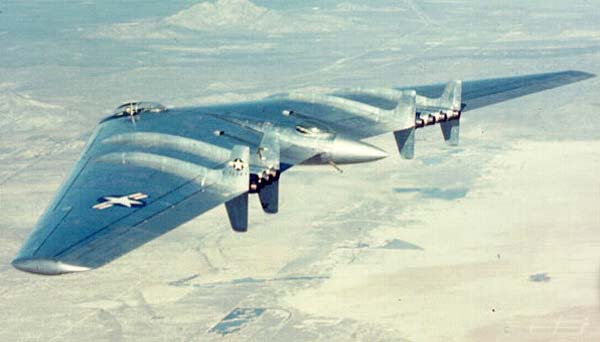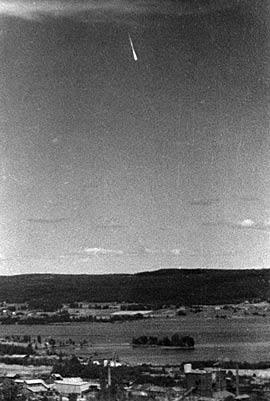The Lubbock Lights were an unusual formation of
lights seen over the city of Lubbock, Texas from August–September 1951. The
Lubbock Lights incident received national publicity and is regarded as one of
the first great UFO
cases in the United States.

The first publicized sighting of the lights occurred on
August 25, 1951, at around 9 pm. Three professors from Texas Technological
College (now Texas Tech University), located in
Lubbock, were sitting in the backyard of one of the professor's homes when they
observed the "lights" fly overhead. A total of 20-30 lights, as
bright as stars but larger in size, flew over the yard in a matter of seconds.
The professors immediately ruled out meteors as a possible cause for the
sightings, and as they discussed their sighting a second, similar, group of
lights flew overhead.
The three professors - Dr. A.G. Oberg, chemical engineer,
Dr. W.L. Ducker, a department head and petroleum engineer, and Dr. W.I.
Robinson, a geologist - reported their sighting to the local newspaper, the Lubbock Avalanche-Journal. Following
the newspaper's article, three women in Lubbock reported that they had observed
"peculiar flashing lights" in the sky on the same night of the
professor's sightings. Dr. Carl Hemminger, a professor of German at Texas Tech,
also reported seeing the objects, as did the head of the college's journalism
department.
The three professors became determined to view the
objects again and perhaps discover their identity. On September 5, 1951, all
three men, along with two other professors from Texas Tech, were sitting in Dr.
Robinson's frontyard when the lights flew overhead. According to Dr. Grayson
Mead the lights "appeared to be about the size of a dinner plate and they
were greenish-blue, slightly fluorescent in color. They were smaller than the
full moon at the horizon. There were about a dozen to fifteen of these
lights...they were absolutely circular...it gave all of us...an extremely eerie
feeling." Mead claimed that the lights could not have been birds, but he
also stated that they "went over so fast...that we wished we could have
had a better look." The professors observed one formation of lights flying
above a thin cloud at about 2,000 feet (610 m); this allowed them to calculate
that the lights were traveling at over 600 miles per hour (970 km/h).
The Hart
photographs

On the evening of August 30, 1951, Carl Hart, Jr., a
freshman at Texas Tech, was lying in bed looking out of the window of his room
when he observed a group of 18-20 white lights in a "v" formation
flying overhead. Hart took a 35-mm Kodak camera and walked to the backyard of
his parent's home to see if the lights would return. Two more flights passed
overhead, and Hart was able to take a total of five photos before they
disappeared. After having the photos developed Hart took
them to the offices of the Lubbock Avalanche-Journal. After examining
the photos the newspaper's editor, Jay Harris, told Hart that he would print
them in the paper, but that he would "run him (Hart) out of town" if
the photos were fake. When Hart assured him that the photos were genuine,
Harris paid Hart $10 for the pictures. The photographs were soon reprinted in
newspapers around the nation, and were printed in LIFE magazine, thus
giving them wide publicity. The physics laboratory at Wright-Patterson Air Force Base
in Ohio analyzed the Hart photographs. After an extensive analysis and
investigation of the photos, Lieutenant Edward J.
Ruppelt, the supervisor of the Air Force's Project Blue
Book, released a written statement to the press that "the
[Hart] photos were never proven to be hoax, but neither were they proven to be
genuine." Hart has consistently maintained to this day
that the photos are genuine. Curiously, the Texas Tech professors claimed that
the photos did not represent what they had seen, since their objects had flown
in a "u" formation instead of the "v" formation depicted in
Hart's photos.
Air Force
investigation and controversy
In late September 1951, Lieutenant Ruppelt read about the
Lubbock Lights and decided to investigate them.
Project Blue Book,
founded in 1948 as Project Sign, was the Air Force's official
research group assigned to investigate UFO reports. Ruppelt traveled to Lubbock
and interviewed the professors, Carl Hart, and others who claimed to have witnessed
the lights. Ruppelt's conclusion at the time was that the professors had seen a
type of bird called a plover. The
city of Lubbock had installed new vapor street lights in 1951, and Ruppelt
believed that the plovers, flying over Lubbock in their annual migration, were
reflecting the new street lights at night. Witnesses who supported this
assertion were T.E. Snider, a local farmer who on August 31, 1951 had observed
some birds flying over a drive-in movie theater; the bird's undersides were
reflected in the light. Another
witness, Joe Bryant, had been sitting outside his home with his wife on August
25 - the same night on which the three professors had first seen the lights.
According to Bryant, he and his wife had seen a group of lights fly overhead,
and then two other flights. Like the professors, they were at first baffled by
the objects, but when the third group of lights passed overhead they began to
circle the Bryant's home. Mr. Bryant and his wife then noticed that the lights
were actually plovers, and could hear them as well. In addition, Dr. J. Allen
Hynek, an astronomer and one of Project Blue Book's scientific
consultants, contacted one of the Texas Tech professors in 1959 and learned
that the professor, after careful research, had concluded that he had actually
been observing the plovers.
However, not everyone agreed with this explanation.
William Hams, the chief photographer for the Lubbock Avalanche-Journal,
took several nighttime photos of birds flying over Lubbock's vapor street
lights and found that he could not duplicate Hart's photos - the images were
too dim to be developed. Dr. J.C. Cross, the head of Texas Tech's biology
department, ruled out the possibility that birds could have caused the
sightings. A game warden Ruppelt interviewed felt that the sightings could not
have been caused by plovers, due to their slow speed (50 mph or 80 km/h) and
tendency to fly in groups much smaller than the number of objects reported by
eyewitnesses. The warden did
admit that an unusually large number of plovers had been seen in the fall of
1951. Dr. Mead, who had observed the lights, strongly disputed the plover
explanation: "these objects were too large for any bird...I have had
enough experience hunting and I don't know of any bird that could go this fast
we would not be able to hear...to have gone as fast as this, to be birds, they
would have to have been exceedingly low to disappear quite so quickly. Curiously, in his bestselling 1956 book The
Report on Unidentified Flying Objects, Ruppelt himself would come to reject
the plover hypothesis, but frustratingly refrained from explaining what
the lights in fact were:
"They weren't birds, they weren't refracted light,
but they weren't spaceships. The lights ... have been positively identified as
a very commonplace and easily explainable natural phenomenon. It is very
unfortunate that I can't divulge ... the way the answer was found.... Telling
the story would lead to [the identity of the scientist who "finally hit
upon the answer"] and ... I promised the man complete anonymity."
The flying wing
While investigating the Lubbock Lights, Ruppelt also
learned that several people in and around Lubbock claimed to have seen a "flying wing"
moving over the city. Among the witnesses was the wife of Dr. Ducker, who
reported that in August 1951 she had observed a "huge, soundless flying
wing" pass over her house. Ruppelt knew that the US Air Force did possess
a "flying wing" jet bomber, and he felt that at least some of the
sightings had been caused by the bomber, although he could not explain why,
according to the witnesses, the wing made no sound as it flew overhead.

